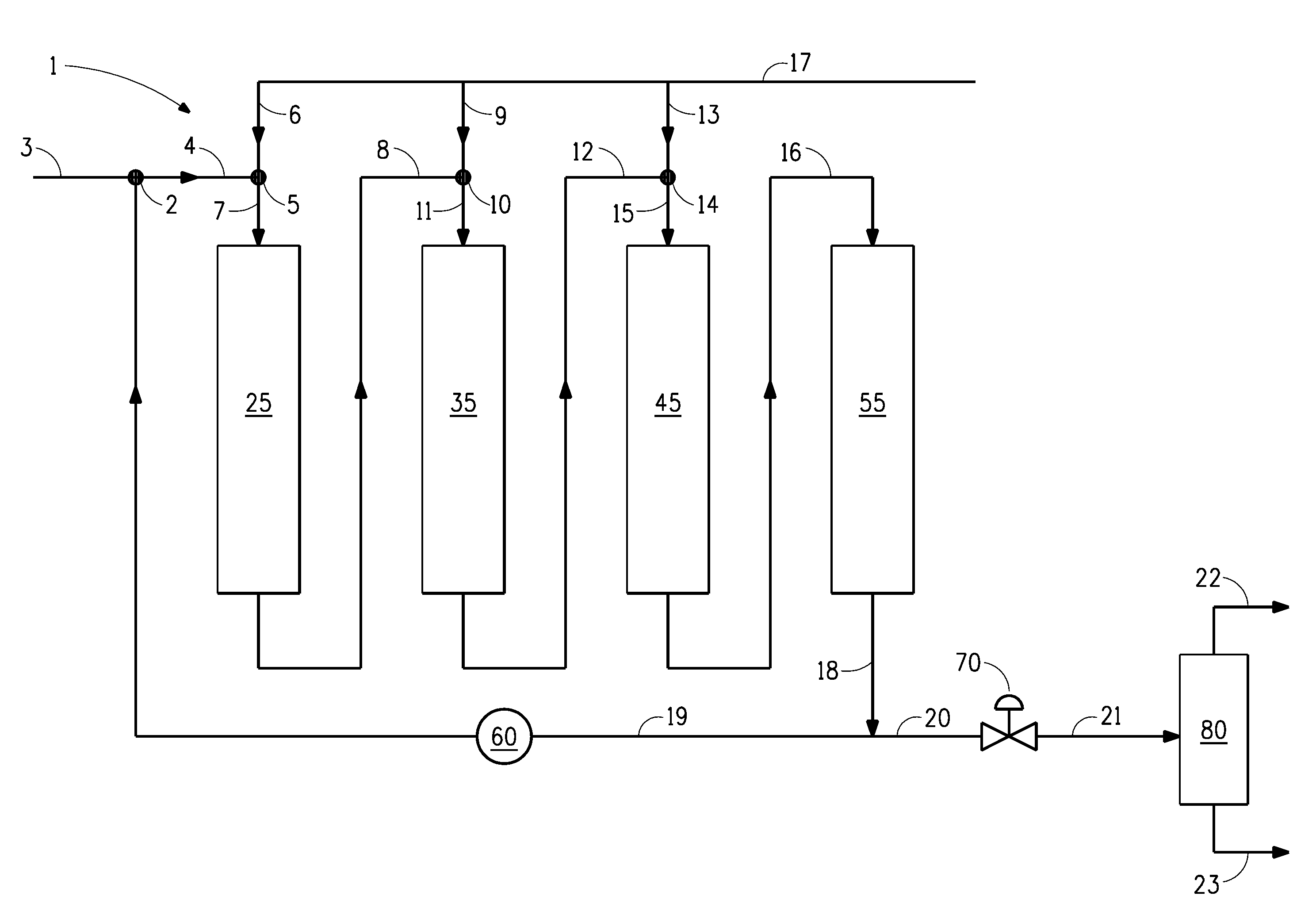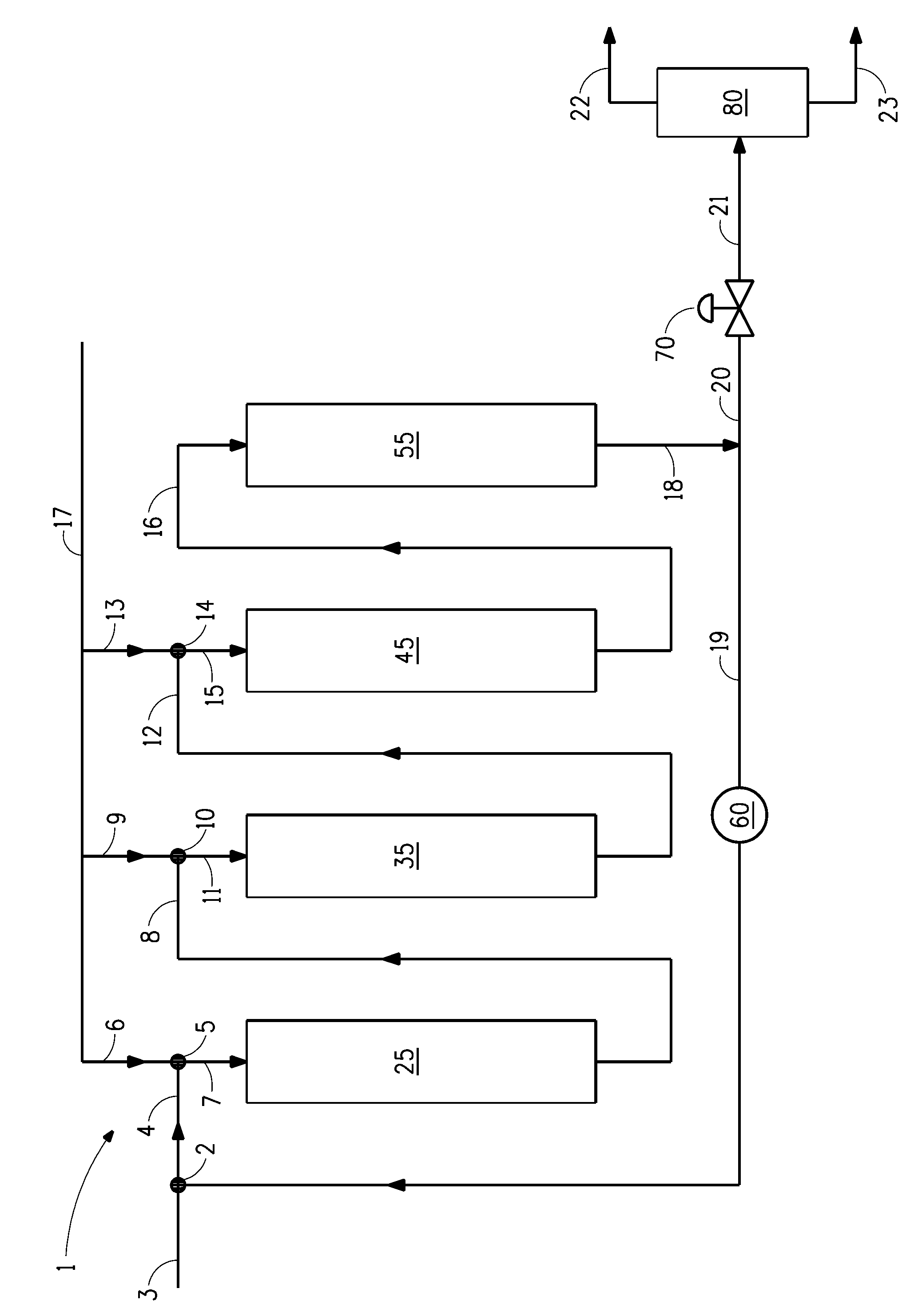Targeted pretreatment and selective ring opening in liquid-full reactors
a liquid-full reactor and selective ring technology, applied in the direction of hydrocarbon oil treatment products, aromatic hydrocarbon hydrogenation, refining to eliminate heteroatoms, etc., can solve the problems of few options for their use, low commercial value of options available, and inability to directly blend oil into diesel fuel
- Summary
- Abstract
- Description
- Claims
- Application Information
AI Technical Summary
Benefits of technology
Problems solved by technology
Method used
Image
Examples
examples
Analytical Methods and Terms
[0051]ASTM Standards. All ASTM Standards are available from ASTM International, West Conshohocken, Pa., www.astm.org.
[0052]Amounts of sulfur, nitrogen and basic nitrogen are provided in parts per million by weight, wppm.
[0053]Total Sulfur was measured using ASTM D4294 (2008), “Standard Test Method for Sulfur in Petroleum and Petroleum Products by Energy Dispersive X-ray Fluorescence Spectrometry,” DOI: 10.1520 / D4294-08 and ASTM D7220 (2006), “Standard Test Method for Sulfur in Automotive Fuels by Polarization X-ray Fluorescence Spectrometry,” DOI: 10.1520 / D7220-06
[0054]Total Nitrogen was measured using ASTM D4629 (2007), “Standard Test Method for Trace Nitrogen in Liquid Petroleum Hydrocarbons by Syringe / Inlet Oxidative Combustion and Chemiluminescence Detection,” DOI: 10.1520 / D4629-07 and ASTM D5762 (2005), “Standard Test Method for Nitrogen in Petroleum and Petroleum Products by Boat-Inlet Chemiluminescence,” DOI: 10.1520 / D5762-05.
[0055]Aromatic content...
examples 1-3
[0068]The properties of a gas oil (GO) from a commercial refiner are shown in Table 1. The GO was hydroprocessed in an experimental pilot unit containing four fixed bed reactors in series. Each reactor was of 19 mm (¾″) OD 316 L stainless steel tubing and about 61 cm (24″) in length with reducers to 6 mm (¼″) on each end. Both ends of the reactors were first capped with metal mesh to prevent catalyst leakage. Below the metal mesh, the reactors were packed with layers of 1 mm glass beads at both ends. Catalyst was packed in the middle section of the reactor.
[0069]
TABLE 1Properties of Gas Oil used in Examples 1 and 2PropertyUnitValueSulfurwppm19900Nitrogenwppm935Density at 15.6° C. (60° F.)g / ml0.9198API Gravity22.2Boiling Point Distribution %° C.IBP 24953281035620386304074042550442604617048180504905339555499583FBP 591IBP = Initial boiling pointFBP = Final boiling point
[0070]The first two reactors, Reactors 25 and 35, were used for targeted pretreatment (“PT”). Reactors 1 and 2 contain...
examples 4-8
[0079]A 100% light cycle oil (LCO) from a FCC unit of a petroleum refinery having the properties set forth in Tables 3 and 4 was hydroprocessed in the pilot unit described in Example 1, with certain modifications.
[0080]
TABLE 3Properties of Light Cycle Oil used in Examples 4 to 8Preferred PropertyUnitMeasuredDiesel SpecsSulfur contentwppm4980Nitrogen contentwppm671Density at 15.6° C.g / ml0.94090.860Density at 20° C.g / ml0.9377API Gravityg / ml18.7Refractive Index at 20° C.1.544Bromine Numberg / 100 g 5.0Cetane Index24.6Increase >+12Aromatic contentMonoaromaticswt %22.7Polyaromaticswt %45.6Total Aromatics wt %68.3
[0081]
TABLE 4Boiling Point Distribution of LCO used in Examples 4 to 8Simulated distillation,Boiling Pointwt %° C. (° F.)Initial Boiling Point (IBP)104 (218) 5%205 (401)10%237 (459)20%260 (500)30%269 (516)40%284 (544)50%297 (566)60%310 (589)70%329 (625)80%346 (655)90%362 (684)95%370 (699)99%394 (741)End Point (EP)414 (778)
[0082]Tables 3 and 4 show that, compared to a diesel sample,...
PUM
| Property | Measurement | Unit |
|---|---|---|
| end boiling point | aaaaa | aaaaa |
| temperature | aaaaa | aaaaa |
| density | aaaaa | aaaaa |
Abstract
Description
Claims
Application Information
 Login to View More
Login to View More - R&D
- Intellectual Property
- Life Sciences
- Materials
- Tech Scout
- Unparalleled Data Quality
- Higher Quality Content
- 60% Fewer Hallucinations
Browse by: Latest US Patents, China's latest patents, Technical Efficacy Thesaurus, Application Domain, Technology Topic, Popular Technical Reports.
© 2025 PatSnap. All rights reserved.Legal|Privacy policy|Modern Slavery Act Transparency Statement|Sitemap|About US| Contact US: help@patsnap.com


